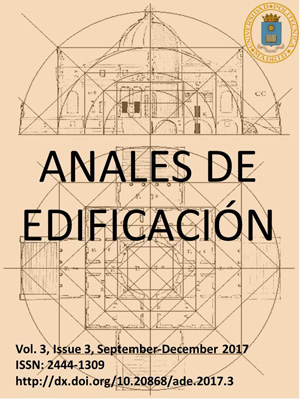La rehabilitación de un ícono de la modernidad la Iglesia Mater Misericordiae = The rehabilitation of an icon of modernity the Church Mater Misericordiae
DOI:
https://doi.org/10.20868/ade.2017.3675Palabras clave:
Rehabilitación de cerramientos ligeros, Arquitectura Sacra, Arquitectura Moderna, Nuevos materiales, Rehabilitation of light closings, Sacred Architecture, Modern Architecture, New materialsResumen
La iglesia Mater Misericordiae es un edificio sacro levantado en Baranzate (Milán) a finales de la década de los años 50.Supone la culminación de una serie de experiencias que pretendían la renovación de la liturgia y, con ello, la renovación de laarquitectura. Su construcción, enmarcada dentro de un plan más amplio acometido por el Arzobispado de Milán, supuso un gran avance en varios campos relacionados, principalmente, con la modernidad de la arquitectura sacra, la construcción y las nuevas tecnologías. Incorpora el uso no solamente del hormigón, material poco utilizado hasta ese momento en construcciones sacras, sino que, además, introduce un sistema de prefabricación y postesado “In situ” para la ejecución de la estructura que muestra el interés de los técnicos de la época por hallar nuevos medios de sistematización de la construcción. El sistema constructivo de cerramiento utilizado permite delimitar el espacio litúrgico mediante una piel translúcida que rodea el espacio, permitiendo la entrada de luz natural durante el día y la iluminación del entorno durante la noche. La presente investigación trata sobre las diferentes soluciones que se han empleado en la resolución de las fachadas de cerramiento, haciendo especial hincapié en la solución utilizada en la última rehabilitación a la que ha sido sometida. En este caso se han tratado de incorporar las tecnologías modernas más avanzadas para la resolución de los problemas que esta presentaba pero respetando al máximo la idea del proyecto original.
Abstract
The church Mater Misericordiae is a sacred building raised in Baranzate (Milan) at the end of the decade of the 50s. It supposes the culmination of a series of experiences that were claiming the renovation of the liturgy and, with it, the renovation of the architecture. His construction, framed within a broader plan undertaken by the Archbishopric of Milan, supposed a great advance in several fields related, principally, with the modernity of the sacred architecture, the construction and the new technologies. It incorporates the use not only of concrete, material little used until that moment in sacred constructions, but also, it introduces a prefabrication and post-tensioned system "In situ" for the execution of the structure that shows the interest of the technical personnel of the epoch to find new means of systematizing of the construction. The constructive system of used closing allows to delimit the liturgical space by means of a translucent skin that surrounds the space, allowing the entry of natural light during the day and the lighting of the environment during the night. The present investigation treats on the different solutions that have used in the resolution of the fronts, doing special support in the solution used in the last rehabilitation to which it has been submitted. In this case they have tried to incorporate each other the modern technologies most advanced for the resolution of the problems that this one was presenting but respecting to the maximum the idea of the original project.
Descargas
Referencias
Barazzetta, G. (1958). Il progetto di restauro della Chiesa Mater Misericordiae (1957-1958) en, Il vetro nell’architettura del XX secolo: conservazione e restauro, compilado por Franz.
Barazzetta, G. (2014). ARCHI: Rivista svizzera di architettura, ingegneria e urbanística, Il restauro di un involucro degli anni ’50, 5, pp 96-103.
Di Biagi, P. (2010). Revista Visiones, El plan INA-Casa, 1949-1963: barrios y ciudad en la Italia de los años 50, nº 8 noviembre pp. 44.
Gandolfi, V. (1959). Revista Chiesa e quartiere, Sviluppo della pianificazione parrocchiale a Milano, nº 9-10.
Gherardi, L. (1959). Revista Chiesa e Quartiere, Documentazione delle dieci nueve chiese, nº 9-10, pp. 43-89.
Mangiarotti, A. (2011). TECHNE: Journal of Technology for Architecture & Environment, Re-innovare. Il Contributo della ricerca tecnologica di Nostra Signora della Misericordia a Baranzate, Vol. 1, pp 138-143.
Descargas
Publicado
Número
Sección
Licencia
1. Los autores conservan los derechos de autor y garantizan a la revista el derecho de una Licencia Creative Commons Atribución - Nocomercial 4.0 Internacional que permite a otros compartir el trabajo con un reconocimiento de la autoría y uso no comercial.
2. Los autores pueden establecer por separado acuerdos adicionales para la distribución no exclusiva de la versión de la obra publicada en la revista (por ejemplo, situarlo en un repositorio institucional o publicarlo en un libro).
Salvo indicación contraria, todos los contenidos de la edición electrónica se distribuyen bajo una licencia de uso y distribución “Creative Commons"












